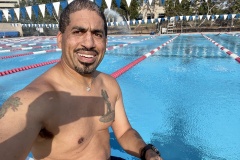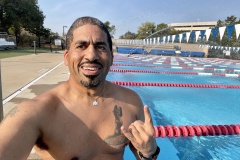I have been training with the TriDot AI-based platform for two months now. During this period, I established baseline performance metrics, which were then used to create an initial training plan. The platform evaluates the results of every training session and adjusts the plan continuously, accounting for environmental factors.
The training is programmed in four-week blocks. Each week increases the intensity and duration of the previous week. Then, the fourth week is a lower-intensity recovery week with performance assessments of each discipline. The results of the performance assessments are used to increase or decrease the training load for the next four-week cycle.
Swimming faster again!
I recently discovered the effectiveness of the TriDot Pool School in improving my 100-yard freestyle time. After practicing their technique, I was excited to see how it affected my 200 and 400-yard swim speeds. I also hoped it could improve my critical swim speeds (CSS). Luckily, I was in Austin on the day of my swim assessment, so I arranged to use the Austin Aquatic Center (which is my favorite pool). Jen Reinhart, who coaches a master’s swim program there, kindly reserved a lane for me that morning.
After warming up, I attempted the 400 yd test, which was challenging. It’s difficult to maintain the right amount of effort for sixteen lengths. If I start too fast, I’ll get tired before the end of the test. But if I swim too slowly, the result won’t reflect my best effort. In the end, it takes multiple attempts to get it right. Although I felt tired, I wasn’t pushing myself to my limit. So, I plan to go harder on the next test. Coach Jen was on the deck as I completed the last length and informed me that I finished with a pace of 1 minute and 38 seconds per 100 yards.
My watch recorded a finish time of 6 minutes and 38 seconds, an average pace of 1 minute 40 seconds per 100 yards. A personal best.
After completing a few laps to cool down, Coach Jen recommended that I increase my stroke rate during the 200-yard test as she felt I could improve my pace without compromising my technique. Although I knew it was risky to make changes during a test, I decided to try it. Low turnover or cadence is a recurring issue in all three disciplines, and I have been working on increasing my running cadence from 156 steps/min to around 180, as well as my cycling cadence from the high 60s to 80 or more. Therefore, I thought it would be the perfect opportunity to increase my stroke rate and see how it affects my performance.
After my heart rate returned to normal, I pushed off the wall to begin the 200 yd test. I found that the key to a high turnover was to slightly reduce the force of my pull while maintaining the fullness of the stroke. Throughout each length, I focused on deep rhythmic breathing to prevent my heart rate from spiking, hip rotation, and keeping my hips high in the water. By the sixth length, I breathed heavily, and my arms began feeling fatigued. Nonetheless, I was pacing better than I did during the 400 and felt confident. I knew that I was swimming at a faster pace, and that excitement helped me to sustain my effort for the last lap.
The finish time was 3 minutes and 5 seconds, with an average speed of 1 minute and 33 seconds per 100 yards. This marks another personal best.
Pushing Watts Again!
I enjoy cycling but haven’t been focusing on increasing my FTP. As a result, although my legs feel strong and I can ride for hours, my threshold has decreased from its peak. TriDot’s training approach is to prioritize speed before endurance. Consequently, they assign sessions that develop speed first; then, as the race-preparation phase approaches, they increase the duration of each session. The past two months of bike workouts have been intense. The interval sessions, which last no more than an hour, have been exhausting, so I was eager to see if my FTP had improved.
As with a typical bike threshold assessment, it is conducted indoors because it requires the highest level of effort one can sustain for 20 minutes. For the test, I utilized a pre-set program on Rouvy. I begin by warming up with a 10-minute warmup ride. Since I don’t have much experience with this type of assessment, determining the power level I can sustain for 20 minutes was challenging. So, in my first attempt, I stuck to a level that I was confident I could maintain. After 15 minutes, I felt good and increased the resistance by several watts. Then, at the last minute, I pushed myself harder by increasing the resistance again. Although I felt like I had ridden hard, I believe there is still room for improvement in my next assessment.
The test revealed an FTP of 212 Watts, which is 2.1 W/Kg. It’s not what I’d consider competitive, but it’s an improvement.
Breaking down Run Barriers
Since embarking on my triathlon journey, I have struggled with running, even considering it my personal “Everest.” Despite being more competitive as a swimmer and cyclist, mastering the art of running has always been challenging for me. In the first year, I focused on developing my skills as an open-water competitive swimmer. The second year was spent recovering from prostate surgery and maintaining my fitness gains from year one. In the third year, I became a more confident and competitive cyclist. However, towards the end of last year, I started focusing on developing my running speed. With Johnny’s help, I made a few changes to my training routine. I incorporated running intervals on the track, added weight training twice weekly, and paid close attention to specific aspects of my running form, such as cadence, foot strike position, respiration rate, and body position. These changes have helped me to improve my running and become a better triathlete overall.
At first, I felt awkward trying to run at full speed, as it was something I wasn’t used to, and my natural technique didn’t help. Despite not seeing any significant improvements until this summer, I kept believing that I could become a faster and more efficient runner, and I kept at it. Gradually, I began to experience the feeling of lightness or effortless flow during speed sessions, which was undeniable. This feeling became my motivation, and I chased it whenever possible. Then, all of a sudden, it became easier for me to run faster and for longer, as if I had stepped through a portal. My heart rate didn’t spike as high for a given effort, and my leg muscles didn’t tire as quickly. This made me believe even more that I could keep doing it, and I did. I had entered into a positive feedback loop. Instead of dreading the speed sessions, I began to look forward to testing my limits. Although my legs almost always hurt the next day, I used that to gauge a successful effort. I still can’t keep up with the paces I want for as long as I’d like, but I love the progress and feel much better about running now.
This summer, I faced a challenge as the temperature soared above 100°F for consecutive days, making it difficult to do outdoor speedwork. After several attempts, I realized I couldn’t push my body to perform at its best in such extreme heat. I would overheat too quickly, and my brain went into protection mode, inhibiting intense muscle firing. Instead of repeating the same mistake, I decided to do the 5K time trial on a treadmill in the gym. My goal was to hold an average pace of 8:05 min/mile for 5K, improving my previous best of 8:15 min/mile. However, my real goal was to average a pace of less than 8:00 min/mile. This was an unreasonable goal, but I was determined to achieve it because seven is faster than eight. 😁.
I started my workout routine by climbing onto the treadmill and warming up at a pace of 10 minutes per mile. I consciously decided not to let any doubts enter my mind during the run. Regardless of how I felt, I was determined to achieve my goal for the day, and I knew I could do it. All I needed to do was commit to pushing through any doubts or discomfort that came along. I began the 5k run at a pace of 7 minutes and 30 seconds per mile with a 1% incline. Throughout the run, I focused on maintaining a steady cadence, taking deep and rhythmic breaths, much like I do while swimming. At first, running felt effortless, so I gradually increased the speed. Time flew by faster than expected, but my legs started to wake up, so I slowed down to run at a pace of 8:05 min/mile. It was at that moment that I reminded myself that there would be no doubting myself. It might hurt, but that’s what was required. As I completed two miles, I knew that I would have to fight for the last 1.1 miles, so I increased the treadmill’s speed. If I was going to fight for it, I might as well fight for an unreasonable goal and go for broke. I cranked up the treadmill to run at a pace of sub 8 min/mile, then pushed myself even further. That last mile seemed never-ending, but I finished feeling more determined than ever. I don’t think my fitness has improved significantly; rather, I’ve broken through a mental barrier and will push harder for longer because I believe I can.
My final 5K time was 24 minutes and 21 seconds, averaging 7 minutes and 49 seconds per mile, which is a significant improvement from my previous best.









